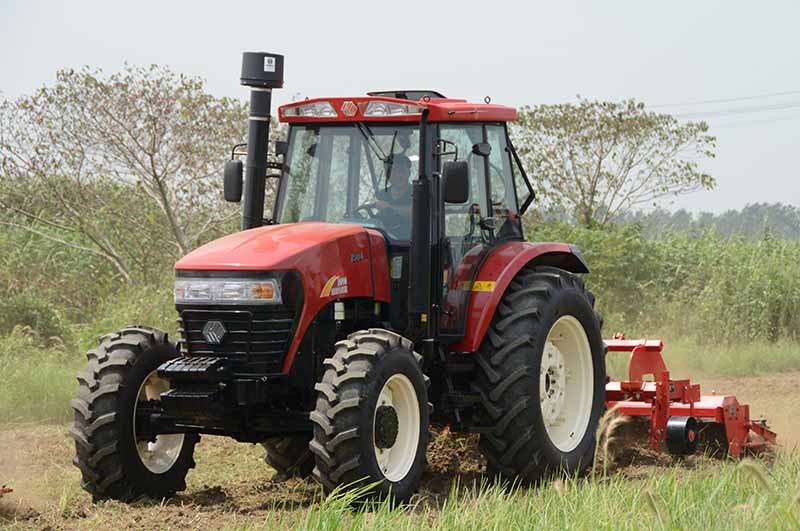10 uses of tractor in agriculture
Date: 2025-06-05 Categories: News
Tractors serve as the backbone of modern agricultural operations, integrating with various implements to streamline farming processes. Here are 10 key uses of tractors in agriculture, supported by technical details and operational insights:
1. Soil Plowing and Tilling (Primary Land Preparation)
- Function:Turn over soil layers (20–30 cm depth) using moldboard plows or disc plows to break up compacted earth, bury crop residues, and improve soil aeration.
- Efficiency:A 100-horsepower tractor with a 3-furrow plow can till 3–5 acres per hour under optimal moisture (15–20% soil water content).
2. Seeding and Fertilizing Integration
- Equipment:Seed drills (row/cavity seeding) paired with fertilizer spreaders.
- Application:Plant crops like wheat or corn while depositing base fertilizer 8–10 cm deep (maintaining 5 cm distance from seeds to prevent burning).
- Precision:Seeding error ≤ 3%, fertilizer distribution deviation ≤ 5% (row spacing adjustable from 15–30 cm for different crops).
3. Rotary Cultivation (Fine Soil Preparation)
- Tool:Rotary tiller (rotating blades).
- Purpose:Break soil into fine particles (10–15 cm depth) for vegetable beds or greenhouse plots, creating a smooth, weed-free surface.
- Output:A 130-horsepower tractor with a 2.5-meter tiller can process 80–100 acres per day.
4. Pest Control and Spraying
- Equipment:Boom sprayers or mounted spray tanks.
- Specs:Spray width 10–15 meters, droplet size 100–300 microns, 10–15 liters of solution per acre.
- Operation:Tractor speed controlled at 5–8 km/h to ensure even coverage, with anti-drip valves for safety.
5. Mulching and Plastic Film Laying
- Tool:Film mulchers for cash crops like cotton or tobacco.
- Function:Simultaneously ridge soil, lay plastic mulch (80–120 cm width), and anchor edges, boosting soil temperature and moisture retention.
- Productivity:20–30 acres per day, 10x faster than manual labor.
6. Root Crop Harvesting
- Attachments:Potato diggers or peanut lifters.
- Process:Extract tubers from 20–30 cm depth, shaking off 95% of soil with ≤ 3% damage rate.
- Capacity:80-horsepower tractor with a 2-meter harvester can harvest 4–6 acres per hour.
7. Grain Crop Combining (with Retrofit)
- Adaptation:Tractor-mounted header or trailed combine for small-scale wheat/rice harvests.
- Performance:Cutting width 2–3 meters, threshing and cleaning in one pass, grain loss ≤ 1.5% (less efficient than dedicated combines but suitable for small fields).
8. Mid-Cultivation and Hilling
- Tools:Cultivators and hillers for row crops like corn or potatoes.
- Role:Loosen soil (5–10 cm depth) to remove weeds, and build 15–20 cm ridges for potato plants to prevent tuber exposure.
- Timing:2–3 passes from seedling to flowering stages.
9. Agricultural Material Transportation
- Configuration:Trailers (2–5 tons payload) or dump beds.
- Applications:Haul fertilizers, seeds, or harvested crops; tracked tractors (ground pressure ≤ 0.2 MPa) suit mountainous terrains.
- Safety:Max speed 20 km/h on unpaved roads, turning radius ≥ 5 meters.
10. Stationary Power Supply
- Function:Drive external equipment via PTO (Power Take-Off) shaft:
- Water pumps (50–100 m³/h flow for irrigation)
- Threshers (1–2 tons/hour grain processing)
- Feed grinders (requires 540/1000 rpm PTO speed matching).
Advanced Applications in Smart Agriculture
- GPS-Aided Precision:Autonomous tractors with ±2.5 cm positioning for variable rate seeding/fertilizing based on soil maps.
- Robotic Operations:Driverless tractors enable 24/7 spraying or tilling in large farms (e.g., 200+ acres daily in US plains).
Operational Tips
- Horsepower Selection:40–60 hp for paddy fields, 80–120 hp for dryland farms.
- Attachments Matching:Ensure PTO speed and implement width align with tractor capacity (e.g., 2.5-meter tiller for 100 hp tractors).
Tractors embody agricultural mechanization’s efficiency, replacing 200–300 manual laborers for 2,000+ acres annually. Their versatility across the farming lifecycle—from soil preparation to post-harvest—makes them indispensable for modern agribusiness.
Tags:
Share:
Prev:
How much does a farm tractor weigh
Next:
Next:



